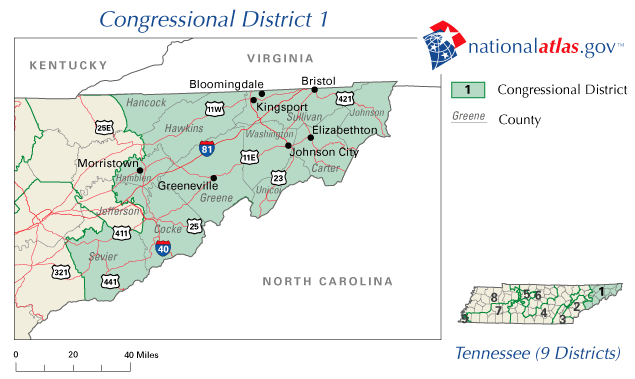- Tennessee's 1st congressional district
Infobox U.S. congressional district
state = Tennessee
district number = 1
image width = 350
image caption =
representative = David Davis
party = Republican
english area =
metric area =
percent urban =
percent rural =
population = 632,143
population year = 2000
median income = 31,228
percent white = 95.8
percent black = 2.2
percent asian = 0.4
percent native american = 0.2
percent hispanic = 1.5
percent other race = 0.0
percent blue collar =
percent white collar =
percent gray collar =
cpvi = R+14The Tennessee 1st Congressional District is the congressional district of northeast
Tennessee , including all of Carter, Cocke, Greene, Hamblen, Hancock, Hawkins, Johnson, Sullivan, Unicoi, and Washington counties and parts of Jefferson County and Sevier County. Cities and towns represented within the district include Blountville, Bristol, Elizabethton, Erwin, Greeneville, Johnson City, Jonesborough, Jefferson City, Kingsport, Morristown, Mountain City, Roan Mountain, Rogersville, and Sevierville. The 1st District's seat in theU.S. House of Representatives has been held by Republicans since 1881.Andrew Jackson was the first elected U.S. Representative of the Tennessee 1st Congressional District, serving during in 1796-97 before being elected into theU.S. Senate . David Davis, Republican, currently represents the district, having been elected in 2006. He failed to win renomination in the August 2008 Republicanprimary election , losing to Johnson City MayorPhil Roe . [ [http://www.johnsoncitypress.com/Detail.php?Cat=HOMEPAGE&ID=64309 "Roe defeats incumbent Davis for 1st Congressional District nomination"] , "Johnson City Press", August 8, 2008]Political characteristics
The 1st has generally been a very secure voting district for the Republican Party since the
American Civil War , and is one of only two ancestrally Republican districts in the state (the other being the neighboring 2nd district). and for all but four years since 1859, while Democrats (or their antecedents) have held the congressional seat for all but six years from when Andrew Jackson was first elected to the U.S. House of Representatives in 1796 up to the term of Albert Galiton Watkins ending in 1859.Two elected Democratic representatives from the Tennessee 1st Congressional District - Andrew Jackson and
Andrew Johnson - later ascended to the office ofPresident of the United States .The 1st was one of only two districts in Tennessee whose congressmen did not resign when Tennessee seceded from the Union in 1861.
George Washington Bridges was elected as a Unionist (the name used by a coalition of Republicans, northern Democrats and anti-Confederate Southern Democrats) to the Thirty-seventh Congress, but he was arrested by Confederate troops while en route toWashington, D.C. and taken back to Tennessee. Bridges was held prisoner for more than a year before he made his escape and went to Washington, D.C., and assumed his duties onFebruary 23 ,1863 ; serving untilMarch 3 ,1863 .Like the rest of East Tennessee,
slavery was not as common in this area as the rest of the state due to its mountain terrain, which could not support aplantation economy . [ [http://tennesseeencyclopedia.net/imagegallery.php?EntryID=S044 Tennessee Encyclopedia of History and Culture: Slavery] ] The district was also the home of the first abolitionist periodicals in the nation, "The Manumission Intelligencer" and "The Emancipator", founded in Jonesborough in 1819. [ [http://www.waymarking.com/waymarks/WM40Y2 Waymarking: First Abolition Publications] ]Due to these factors, this area supported the Union over the Confederacy in the Civil War, and identified with the Republican Party after Tennessee was readmitted to the Union in
1867 , electing candidates representing the Republican-related Unionist Party both before and after the war. This allegiance continues to this day, with Republicans dominating every level of government. While a few Democratic pockets exist in the district's urban areas, they are not nearly enough to sway the district.The district tends to give its congressmen very long tenures in Washington. Four men have held the district's seat for all but six of the last 87 years.
Representatives
From
September 3 ,1794 toJune 1 ,1796 , theTerritory South of the River Ohio (the Southwest Territory) was represented in theUnited States House of Representatives by a non-voting delegate. OnJune 1 ,1796 , the territory was organized into the state of Tennessee.ource
* [http://politicalgraveyard.com/geo/TN/ofc/usrep.html Political Graveyard database of Tennessee congressmen]
References
Wikimedia Foundation. 2010.
